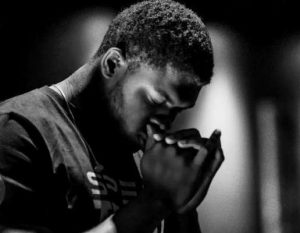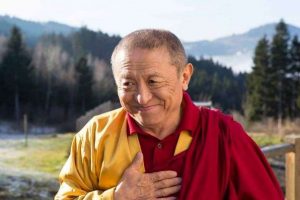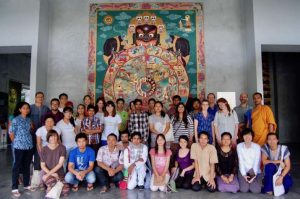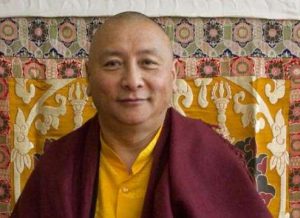Play is training for the real thing. But the real thing is also play. (Thich Nhat Hanh)
Ritual grew up in sacred play; poetry was born in play and nourished on play; music and dancing were pure play. . . . We have to conclude, therefore, that civilization is, in its earliest phases, played. It does not come from play . . . it arises in and as play, and never leaves it. (Johan Huizinga, cultural historian, 1872–45)

I love watching children play—how single-mindedly, driven by some inner necessity, they pursue their games, repeating and perfecting an arrangement of objects or the unfolding of a drama. I am captivated by that aura of absorption, abandonment to the moment, concentration and focus, responsiveness to new influences, the sideways swaying into the unexpected, the leaps of imagination. It reminds me of the happy self-forgetting that was part of my own childhood and it puts me into the mood for meditation, which is characterized by much of the same qualities. I wonder: what would it be like if more of our adult lives were infused by the spirit of playfulness? What is its place in a world dominated by utilitarian and materialistic influences, so far removed from the origins of civilization in play, as suggested by Dutch historian Johan Huizinga?
As a young student at the Folkwang university in Essen, Germany, I had the great privilege to earn a BA by spending many hours each week . . . playing. Apart from piano and cello, my main subject was Dalcroze Eurythmics, an educational method that combines all the arts, particularly music and movement, as well as taking inspiration from poetry and visual arts. We improvised for hours, conjuring music in response to movement, and vice versa, mirroring, juxtaposing, and augmenting each other’s acts of creative expression. It is an integrative artform that employs the universal formal principles that shape much of nature and art: repetition, randomness, variation, contrast, balance, etc. A vital part of the skills I learned was the structuring of a session—taking people, step-by-step, from easy, confidence-building tasks to immersion in free-flowing expression, with body, voice, other people and various implements.
I use this approach in some of my mindfulness courses and retreats, without using the words “art” or “improvisation,” which are likely to trigger many people’s inner critics. For example, during the practice of mindful walking, we may pay attention not just to our own bodily sensations, although that is a starting point, but to our spatial relationships within the physical environment and the other movers. We may start playing with simple parameters, like walking and standing, the length of time standing, the pace of walking, the orientation in space—and before we know it, we find ourselves part of an improvisational unfolding that takes us beyond the confines of our separate little selves into an unselfconsciously aware current of interconnectedness. People later often comment that they felt part of a modern dance performance—part of something aesthetically compelling. They felt socially liberated, being truly and deeply themselves while being part of a group. These insights were arrived at kinesthetically, not just through words but through lived, multisensory experience.
Eurhythmics hadn’t been my first choice of subject; I had set out on a path toward becoming a conventional high school music teacher, but it soon became clear that respectability was not that high on my list of values—and hasn’t been since. I was drawn to finding out, in experiential ways, what my true values were; how to be less split off from the body, less shaped by alienating cultural and economic norms, and eurhythmics was a gateway. Some of my friends in the improv scene also meditated regularly and went on Buddhist retreats—it seemed a natural fit. It became increasingly clear that my life was also going in that direction—why not make what I loved the main thing in my life? “Follow your bliss” as Jospeh Campbell recommends. Not that meditating and immersion in the arts didn’t have their challenges—a great deal of inner healing also took place. In my mid-20s, I left Germany to become involved in various Buddhist projects in the UK, including helping to set up Taraloka Retreat Centre for women and eventually becoming an ordained Buddhist within the Triratna order. I became interested in bringing my multi-strand artistic approach to the exploration of ritual and eventually completed an arts-based PhD at Dartington College: Gestures towards Emptiness: An Exploration of Buddhist Tradition and Innovation. The process involved a broad study of ritual, leading and documenting many workshops and retreats and it turned me into a visual artist.
People often comment on the musicality of my art work, which doesn’t surprise me. When I paint, I become absorbed in the making, spontaneously responding to the constantly shifting impulses that seem to emanate from the work, as if we, the painting and I, are improvising a piece of music. I enjoy rhythmical mark-making, a kind of dancing on paper which takes precedence over the part of me that wants to keep things all planned out, sorted, neat and presentable. Saying that, clarity of intention and a limited use of materials and formal parameters are an important part of the process too. Sometimes the spirit of playfulness eludes me and I overwork a piece in the pursuit of perfectionism. I need to leave it be for a while then, but rather than considering it a failure, I am increasingly able to see it as a gift. After a few days or weeks, I can approach it afresh, and often, with a gratefully received flash of inspiration, a next step suggests itself. The seemingly “ugly” becomes an underlayer that informs the subsequent application of paint and provides grit and a satisfyingly rich texture. My meditation practice helps with this, as I do my best to welcome all aspects of me—the sad, tense, scared, judgmental, and driven, as well as the joyful, playful, calm, relaxed, accepting, and compassionate.
Repetition can have an overly soothing effect, and I like the challenge of introducing degrees of variation and unpredictability to create a balance between order and chaos/liveliness. If there is a thread running through my work, it is trying to convey, in a playful manner, a sense of awareness, and presence. The title image of my recent show, “pause for presence” shows a central oblong shaft of light within a busy, urban-seeming liveliness, suggesting a portal into awareness. Everything is allowed to be what it is, suffused by light.

Mindfulness teachers often talk about shifting from the “doing mode” into “being mode.” I have been experimenting with shifting into “play mode,” which has elements of both states, energy and relaxation, and that extra, surprising, joyful tingle of creativity and expanded relatedness. In everyday life, caught, say, between answering urgent emails and cooking dinner, when I notice the tension creeping into my shoulders and jaws, I try to remember playfulness as an option. Often, an instantaneous attitudinal shift takes place and I find myself smiling, sighing a deep breath of relief—ah, it’s a game. Taking a moment to jiggle the body looser, with or without music helps. Things will still get done, but in a different way, as part of a bigger dance, with less of a sense of “me,” taking “myself” less seriously.
“Play is training for the real thing. But the real thing is also play,” Thich Nhat Hanh said. What are your most accessible ways into playful living, where seriousness, a sense of purpose and a lightness of approach merge? Tossing a stick for a dog, spending time with children, joking with a friend, or taking photos? I think the key is to recognize those moments of natural playfulness and creativity, giving them value and letting those fleeting states grow into a more continuous way of being. It certainly helps to engage in activities traditionally classed as “arts and crafts,” learning to play an instrument or going to a pottery class. Regular mindfulness meditation gives more ready access to curiosity and vivid sensory awareness that can lighten up the most ordinary activity, like taking a shower or emptying the washing machine. Sometimes, just reframing a situation as play can do the trick—notice how your body and mind respond to that suggestion, how energy shifts almost tangibly to different zones of the brain—maybe something wakes up at the base of your spine, or in your heart, or the breath deepens. Try it in your meditation, or during conversations, or even when bogged down by political and ecological global developments.
Playfulness implies relaxing into conscious relationships, regarding objects, tasks, fields of color or words in the light of some intuited overarching meaning, as yet unknown in its fulness, and twirling towards its realization.
See more
What is Dalcroze Eurhythmics? (Dalcroze UK)
Taraloka Retreat Centre
Triratna
Gestures towards Emptiness: an Exploration of Buddhist Tradition and Innovation (University of Plymouth)
Related features from BDG
Rewired by Socially Engaged Buddhists
Tsechu in Sikkim: The Guru’s Gift
Give Peace a Chance
Ratnadevi’s Playful Approach to Mindfulness and Yoga














